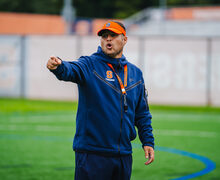Beyond The Hill : Club culture: Yale students studied New York City clubs, music in class
This past semester, Yale University offered a course that focused on why people went out at night, what thrills the experience of nightlife provided and how the rhythms and bass tempos of dance music set the tone for those outings.
The course, officially called ‘Dance Music and Nightlife Culture in New York City,’ was designed and taught by doctoral candidate Madison Moore in the American studies department.
Moore proposed the class to the department, which has a certain number of slots each year for new courses. After the review of a faculty committee, the courses for the following semester are selected, said Matthew Jacobson, chair of the American studies department.
Jacobson said that a course on New York City nightlife is not as bizarre as one might think.
‘There are courses on sports, film and television across the university,’ Jacobson said. ‘Nightlife is a multibillion dollar industry, they’re engaging and they’re engaging numerous different cultural forms, so it doesn’t seem like it’s a strange subject of study.’
Moore designed the class and wrote the syllabus on his own. He based the class on his experiences with popular culture and performance, combined with his own dissertation research.
‘The goal is to help students to realize that something that people think is frivolous, or has no meaning, is actually a good way of understanding issues of race, class and sexuality,’ Moore said.
Despite the class’ interesting subject matter, the material, discussions and topics still involved critical thinking, Jacobson said.
‘This is a serious, analytical course on a set of cultural forms and leisure industries that are important to our understanding of the American city, the politics of race and sexuality, and the history of American music, among other things,’ he said.
The class went beyond simply studying present day nightlife culture in New York City. Moore and his students studied nightlife throughout several periods of history. The syllabus began in the 1890s with the Waldorf-Astoria and was followed by the era of the ‘flapper’ in the 1920s, the Harlem cabarets and the nightclubs of the early 20th century, among other topics.
‘Every creator group that has ever existed has had a nightlife,’ Moore said. ‘Nightlife is not a phenomenon — it’s been around for thousands of years.’
The class was taught in a format that combines traditional lectures and discussions with interactive experiences, Moore said. Some weeks Moore would play a song for the class, and they would dance together to see how the body reacted to dance music.
Students also had the opportunity to visit a New York City club early in the day, before the atmosphere evolved into its typical environment.
The capacity for the class was capped at 18 students, though demand from students was high, Moore said. Moore was flooded with requests to get into the class, and students hoped it would be offered again in the spring, he said.
To the students’ disappointment, the class will not be offered in spring 2012. Moore said he will graduate from Yale next May and intends to take the class to another university in the future, partially due to the overwhelmingly positive response.
‘I’ve had students say that they didn’t know that pop culture could be studied in this way and that the class has really opened their eyes,’ Moore said. ‘It showed them how to experience the world and how to analyze things they didn’t before.’
Published on December 7, 2011 at 12:00 pm
Contact Diana: [email protected] | @dianapearl_




